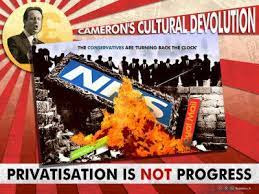|
At the time, the damage caused was little noticed because
government cuts in the first round of austerity targeted local
authorities and adult social care. The first group of people to see their life expectancy fall were elderly women who most often lived on their
own. It was in 2014 that this connection became apparent.
Back then, the government
was still confident, with the Department for Health and Social Care
rebutting any suggestion that austerity and privatisation might be linked
to mortality. The privatisation figures were also opaque. In 2015,
halfway through Jeremy Hunt’s tenure as health secretary, it was reported
that ministers were misleading the public. By that point, private firms were winning
40% of new contracts – far higher than the 6% spend share claimed by the
government and almost identical to the 41% won by NHS bodies.
 | | An open Democracy collage - my thanks to them. |
The first great increase in
mortality was recorded in that same year, 2015: a 5% rise that the government
tried to attribute to influenza. The problem with that explanation was that the stalling
and falls in life expectancy were not seen to the same extent anywhere else in Europe.
By 2019, life expectancy
for women had fallen in almost a fifth of all neighbourhoods and in over a tenth for
men. Poorer people, both old and young, in poorer areas suffered most,
with infant mortality among babies born to the poorest parents rising.
Later, there was a rise in deaths of women who were pregnant.
As NHS waiting lists
spiraled, a tenth of all adults, most of those who could, were resorting to accessing private health care in 2021. But, in doing so, they
lengthened the lists further by jumping the queues and thus diverting
resources.
By April 2022, the number
of vacant beds in hospitals was at an all-time low. Estimates of the damage done kept rising. Less
than six months later, it was claimed that austerity since 2010 had led
to a third of a million excess deaths, twice as many as from the pandemic.
Now, A&E departments
are stretched to capacity, unable to clear patients to other beds in our
hospitals as they could in the past. Those other beds cannot be cleared
as they were before because adult social care has been repeatedly
decimated, with what is left being tendered out to private companies.
All of this was foretold.
 | | Hospital corridor during the present crisis - image from the BMJ, used with thanks |
In the four years after 2015, the value of one group of private sector
contracts in the NHS rose by 89%. These figures were released just before the 2019 general
election, partly in response to Matt Hancock, then the health secretary,
claiming that “there is no privatisation of the NHS on my watch.”
Again, the damage was not
so much through the extent of covert privatisation, but through the wider
ethos that had been promoted. Take the USA: most of the enormous amount
of money spent on healthcare there has little impact on improving health,
because the ethos is wrong.
It is sometimes said –
wrongly, that is – that the NHS has not been further privatised because
the share of its spending that went to the private sector remained
roughly the same between 2012 and 2020. By 2020 that share was about 7%,
or just under £10bn a year. It rose to over £12bn during the pandemic when the government paid
private hospitals to treat patients, but because overall health spending
rose, the proportion remained roughly the same, still around 7%.
But the number of private
companies involved did increase greatly, particularly in areas where
there was already more private healthcare. By last year, private firms were delivering a quarter of all planned NHS
hospital treatment in the least deprived areas of England, and 11% in the
most deprived areas. Those shares – which have risen since 2020 – are
higher than the overall 7% because it is in planned hospital treatment
where the private sector has most infiltrated the NHS.
Last year, the Health and Care Act of 2022 put paid to Lansley’s claim that he had
fixed the NHS ‘once and for all’. The act reduces the compulsion of the
NHS from having to tender so many services to private sector bidding in
future, but it was not designed to stop the rot. It will not solve the
service’s problems, though there is hope that it could be the beginning of
an actual change in ethos.
The pandemic made the
effects of privatisation clear: Britons now have the worst access to healthcare in Europe and some of the worst
post-pandemic outcomes. But the successive health secretaries who
inflicted this tragedy are unrepentant.
In 2018, Lansley criticised Hunt’s cuts in screening services, blaming them for
delaying the detection of his bowel cancer. Hunt, meanwhile, went on to become
foreign secretary and then chancellor of the exchequer. His legacy, as openDemocracy has noted, is “one of missed targets,
lengthening waits, crumbling hospitals, missed opportunities, false
solutions, funding boosts that vanished under scrutiny, and blaming
everyone but himself.”
Hancock, Hunt's successor, is now most remembered for eating a camel
penis and cow anus on live TV for money.
 | | Sometimes, words are not enough. |
Belligerence, bravado and
buffoonery. We got here because too many of us believed the words of
fools.
|





No comments:
Post a Comment